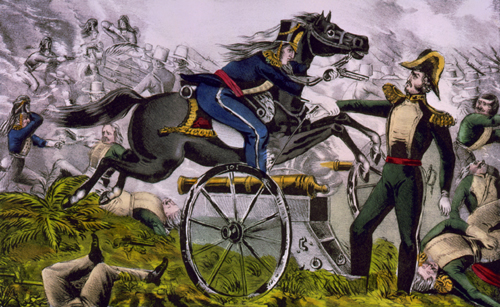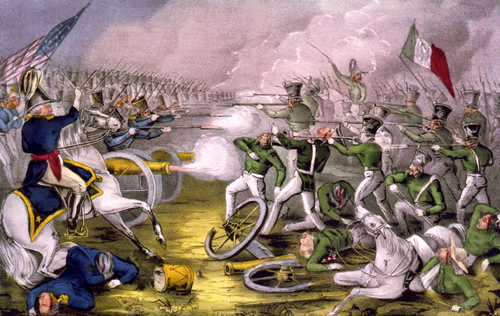"A Wicked War: Polk, Clay, Lincoln, and the 1846 U.S. Invasion of Mexico," by Amy S. Greenberg is Edwin Erle Sparks Professor of History and Women’s Studies at Penn State University

Battle of Resaca de la Palma, May 9, 1846, Courier and Ives, 1846.
From the History News Network, "The Origins of the Latino 'Immigration Problem'," by Amy S. Greenberg, on November 2012 -- In the wake of their recent presidential defeat and losses in many congressional races, Republicans seem to be reaching a consensus that they need to fix their "immigration problem". Despite unprecedented Republican spending on Spanish-language advertising, more than seven out of every ten Latino voters voted Democratic, a higher percentage than in 2000, 2004, and 2008. Even Cuban Americans, once a reliable voting block for the Republicans, failed to turn out in force for Romney; 49 percent chose Obama, a 14-point increase over 2008. Given Republican condemnation of illegal Latino immigration, particularly during the primary, the Latino ticket preference shouldn’t come as much of a surprise. A poll of Latino voters found that 60 percent personally knew an undocumented immigrant, and Mitt Romney suggested that as president he would make life so uncomfortable for undocumented immigrants that they would “self-deport.” As political commentator Bob Price told TexasGOPvote.com, “If we don’t fix the immigration problem, the Republican Party is dead.” Republican strategist Ana Navarro tweeted in the aftermath of the election that “Mitt Romney self-deported himself from the White House.” (source: History News Network)

Battle of Resaca de la Palma, May 9, 1846, Courier and Ives, 1846.
An understanding of our current issues with immigration and 'illegals' must begin with a look back at the U.S.-Mexican War, one of most understudied conflict in American history, and yet key to so much about the modern American project. Those portions of the United States where anti-immigrant fervor has been most heated were taken by force from Mexico in the 1840s. California, southern Texas, Arizona (where all three competitive congressional races went to Democrats), and portions of Colorado (where the Latino vote proved decisive in delivering a supposed swing state to President Obama) were Mexican territory when James K. Polk won election in 1844 on an openly expansionist platform. His Whig opponent, Henry Clay, predicted that Polk’s election would result in war with Mexico, and he was correct. In 1846 Polk oversaw a war of aggression that transferred the northern third of Mexico into U.S. hands. When Polk brought a declaration of war to Congress in May 1846, his Whig opponents capitulated. All but fourteen congressional Whigs voted in favor of war, despite believing that the war was unjust, and started by their own president.(source: History News Network)

The Battle of Palo Alto took place on May 8, 1846, print by E.B. and E.C. Kellogg,1846.
The place of Mexicans in America was as just as politicized in the 1840s as it is today. The standard narrative of the 1846 U.S.-Mexican War claims that it was widely popular among self-proclaimed “Anglo-Saxon” Americans who were convinced that the racially-mixed occupants of Mexico were both inferior and undeserving of their lands. Anti-Mexican sentiment proved a winning issue for Polk and his party in 1844, and the initial public enthusiasm for war was in large part driven by racism. Pro-war newspapers compared Mexicans to vermin, and assured readers that American volunteers would have no problem besting a cowardly enemy and taking as much of their country as they might choose. Democrats successfully deployed anti-Mexican rhetoric both to win election and embark on a war of empire that would eventually, and ironically, result in Anglo residents politically organizing to fight the presence of Mexicans on formally Mexican territory.(source: History News Network)

But the war with Mexico was never as popular among the people of the United States as most historical accounts have indicated. Ministers, politicians, average Americans, and soldiers in the field all critiqued the war. By the late fall of 1847, once isolated voices in opposition to the war coalesced into an antiwar movement that was widespread and vocal enough to persuade President Polk to accept a treaty negotiated by a diplomat, Nicholas Trist, who so opposed the continuation of the war that he defied the president in order to make a treaty that was “fair” to Mexico. Two months before Trist’s Treaty of Guadalupe Hidalgo arrived in Washington, President Polk appeared adamant that any peace treaty with Mexico deliver Baja California and Sonora as well as Alta California and New Mexico. But faced with antiwar agitation in February of 1848, Polk concluded that if he did not accept Guadalupe Hidalgo, “The probability is that Congress would not grant either men or money to prosecute the war ... and I might ... lose ... New Mexico and Upper California.”(source: History News Network)

James K. Polk, the eleventh president of the USA
This narrative might suggest that opponents of the war adopted a humane policy against Mexico, and valiantly brought an unjust war to an end, out of concern for the Mexican people. To a certain extent this is true. My new narrative history of the U.S.-Mexican War documents tremendous acts of personal courage and political risk in the interests of peace.
But a close examination of America’s first national antiwar movement reveals a more complicated story than one of racist Democrats and empathetic Whigs. It wasn’t only pro-war expansionist Democrats who demonized Mexicans; what we would now identify as proto-anti-immigration sentiment mobilized the antiwar movement as well. While many Americans called for an end to the war because they believed it immoral, because they were sickened by reports of atrocities by American soldiers against Mexican civilians, and because they worried that it would open the door for the expansion of slavery, just as many, if not more, demanded that the U.S. withdraw from Mexico because they had no interest in seeing Mexicans in the United States.(source: History News Network)

The Battle of Buena Vista, Mexico was fought fought on February 23, 1847, Courier and Ives, 1847.
Captain John J. Hardin, Abraham Lincoln’s main political rival in Illinois, was an enthusiastic volunteer who longed for war with Mexico. Once he led Illinois volunteers south of the Rio Grande, however, he became skeptical about both the war and Manifest Destiny. “Although I was for annexing all of this part of Mexico to the United States before I came here,” he told a friend, “yet I now doubt whether it is worth it. ... So much for Mexico. Its people are not better than the country -- not more than 1 in 200 is worth making a citizen of.” Anti-Mexican sentiment became particularly pronounced among opponents of the war in the fall of 1847, when U.S. troops had captured Mexico City, and expansionists called for the annexation of all of Mexico as spoils of war. In a widely reported speech that led to public meetings opposed to the war throughout the East and Midwest, Whig leader Henry Clay demanded the immediate withdrawal of U.S. troops, and peace without taking any territory from Mexico. Clay asked his audience, “does any considerate man believe it possible that two ... populations so incongruous, so different in race, in language, in religion and in laws could be blended together in one harmonious mass?” South Carolina senator John C. Calhoun, another active opponent of the war, lodged a “protest against the incorporation of such a people. Ours is the government of the white man.” Even General Winfield Scott, who encouraged Nicholas Trist to conclude his treaty with Mexico, did so, he later wrote, because “as a lover of my country I was opposed to mixing up that race with our own.”(source: History News Network)

The U.S. relationship with Mexico has always been complicated, and America’s first national antiwar movement reflects that reality. There is much to admire in the movement to end “Mr. Polk’s War.” It did, after all, bring a drawn out and bloody conflict, one that cost the lives of 13,000 Americans, and tens of thousands of Mexican, to a close. But its goals were far from pure. The belief in the superiority of an “Anglo-Saxon” America, free from the corruption of racial inferiors, was a potent force for political mobilization in 1847. In the century and a half since, countless politicians have gained office by appealing to that same anti-immigrant impulse. The elections of 2012 mark a break in that history, and the Republican desire to fix its “immigration problem” suggests the future may, in fact, be different. It’s possible that an era begun in the mid nineteenth-century, when politicians could count on anti-Latino sentiment as a winning political issue, is, in fact, at an end. But old problems often prove hard to fix.(source: History News Network)

Treaty of Guadalupe Hidalgo, 1848
In February of 1848 the United States of America and Mexico created the Treaty of Guadalupe Hidalgo. The U.S. paid Mexico 15 million dollars for California and New Mexico. The U.S. also gained present-day Arizona and parts of Colorado, Nevada and Utah. In 1853 during the Gadsden Purchase, the United States bought the lower part of Arizona from Mexico. Mexico had lost close to 55% of its territory because of the war. Mexico had lost its main northern trading town of Santa Fe. To make matters more insulting to Mexico, large of amounts of gold were discovered in California later in 1848 causing one of the biggest gold rushes in modern history. (source:http://shelledy.mesa.k12.co.us/staff/computerlab/Western_CO_History_Mexican_American_War.html#Treaty )


An outstanding share! I've just forwarded this onto a co-worker who has been doing a little homework on this. And he in fact bought me breakfast simply because I stumbled upon it for him... lol. So allow me to reword this.... Thank YOU for the meal!! But yeah, thanx for spending time to talk about this topic here on your web page.
ReplyDeleteMy webpage ; quit smoking support groups online
Hi everybody, here every person is sharing these kinds of know-how, so it's nice to read this website, and I used to go to see this blog every day.
ReplyDeleteLook into my page : affiliate network
Wonderful blog! I found it while surfing around on Yahoo
ReplyDeleteNews. Do you have any tips on how to get listed in Yahoo News?
I've been trying for a while but I never seem to get there! Thanks
my site > free online casinos
TAR does a little better later in the day, in the 10 a.m. to 3 p.m. time slot, where they come in third, behind KESZ in second and KFYI in......
ReplyDelete